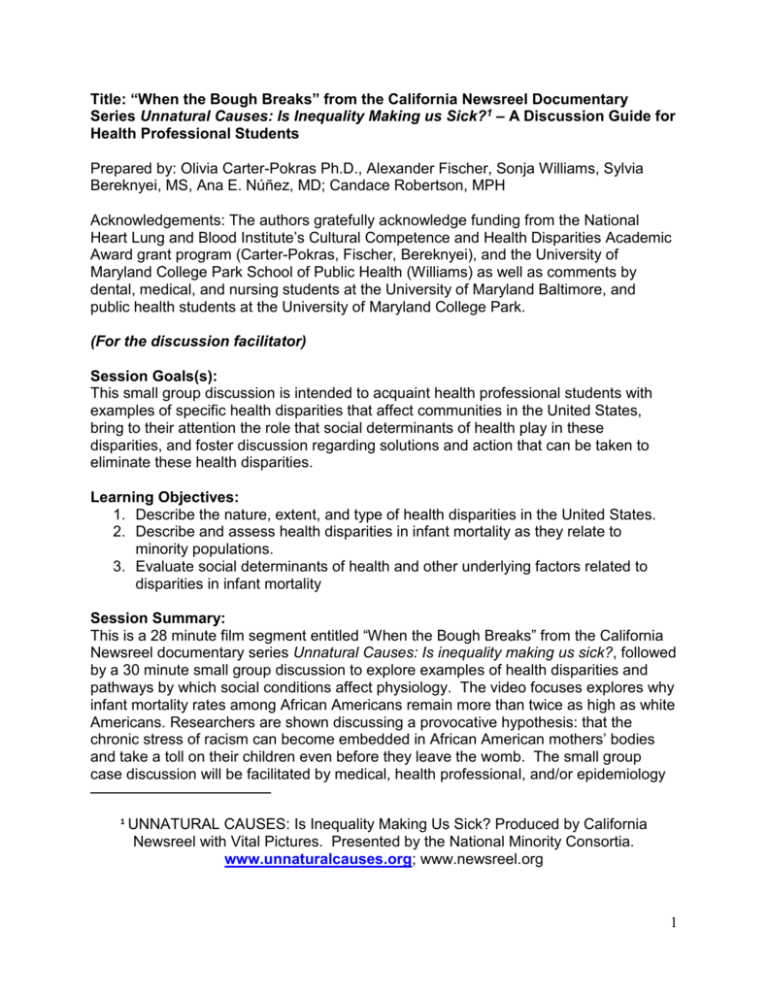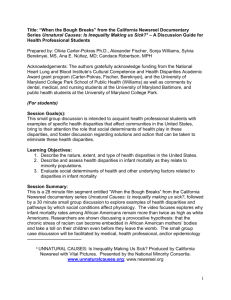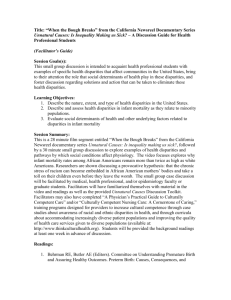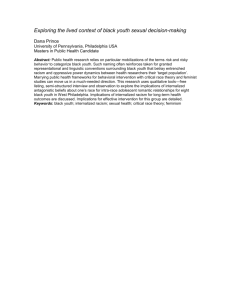Unnatural Causes Whe.. - National Consortium for Multicultural
advertisement

Title: “When the Bough Breaks” from the California Newsreel Documentary Series Unnatural Causes: Is Inequality Making us Sick?1 – A Discussion Guide for Health Professional Students Prepared by: Olivia Carter-Pokras Ph.D., Alexander Fischer, Sonja Williams, Sylvia Bereknyei, MS, Ana E. Núñez, MD; Candace Robertson, MPH Acknowledgements: The authors gratefully acknowledge funding from the National Heart Lung and Blood Institute’s Cultural Competence and Health Disparities Academic Award grant program (Carter-Pokras, Fischer, Bereknyei), and the University of Maryland College Park School of Public Health (Williams) as well as comments by dental, medical, and nursing students at the University of Maryland Baltimore, and public health students at the University of Maryland College Park. (For the discussion facilitator) Session Goals(s): This small group discussion is intended to acquaint health professional students with examples of specific health disparities that affect communities in the United States, bring to their attention the role that social determinants of health play in these disparities, and foster discussion regarding solutions and action that can be taken to eliminate these health disparities. Learning Objectives: 1. Describe the nature, extent, and type of health disparities in the United States. 2. Describe and assess health disparities in infant mortality as they relate to minority populations. 3. Evaluate social determinants of health and other underlying factors related to disparities in infant mortality Session Summary: This is a 28 minute film segment entitled “When the Bough Breaks” from the California Newsreel documentary series Unnatural Causes: Is inequality making us sick?, followed by a 30 minute small group discussion to explore examples of health disparities and pathways by which social conditions affect physiology. The video focuses explores why infant mortality rates among African Americans remain more than twice as high as white Americans. Researchers are shown discussing a provocative hypothesis: that the chronic stress of racism can become embedded in African American mothers’ bodies and take a toll on their children even before they leave the womb. The small group case discussion will be facilitated by medical, health professional, and/or epidemiology 1 UNNATURAL CAUSES: Is Inequality Making Us Sick? Produced by California Newsreel with Vital Pictures. Presented by the National Minority Consortia. www.unnaturalcauses.org; www.newsreel.org 1 faculty or graduate students. Faculty may wish to use this documentary segment to supplement curriculum materials on infant mortality, low birthweight or premature delivery, and/or as a case study for eliciting pertinent social and environmental risk factors in history taking. Facilitators will have familiarized themselves with material in the video and readings as well as the provided Unnatural Causes Discussion Toolkit. Facilitators may also have completed “A Physician’s Practical Guide to Culturally Competent Care” and/or “Culturally Competent Nursing Care: A Cornerstone of Caring,” training programs designed for providers to increase cultural competence through case studies about awareness of racial and ethnic disparities in health, and through curricula about accommodating increasingly diverse patient populations and improving the quality of health care services given to diverse populations (available at: http://www.thinkculturalhealth.org). Students will be provided the background readings at least one week in advance of discussion. Readings: 1. Behrman RE, Butler AE (Editors). Committee on Understanding Premature Birth and Assuring Healthy Outcomes. Preterm Birth: Causes, Consequences, and Prevention. National Academy of Sciences. 2007. Available at: http://www.nap.edu/catalog.php?record_id=11622#toc 2. Jackson FM. Race, Stress, and Social Support: Addressing the Crisis in Black Infant Mortality. Joint Center for Political and Economic Studies. September 2007. 3. David R, Collins J. Disparities in Infant Mortality: What’s Genetics Got to Do With It? American Journal of Public Health 2007;97(7):1191-1197. 4. Howell EA, Hebert P, Chatterjee S, et al., Black/White Differences in Very Low Birth Weight Neonatal Mortality Rates Among New York City Hospitals, Pediatrics 2008;121(3):e407-e415. Additional information on trends over time in disparities in infant mortality: 5. Alexander G, Wingate M, Bader D, Kogan M. The increasing racial disparity in infant mortality rates: Composition and contributors to recent US trends. American Journal of Obstetrics and Gynecology. 2008;198(1):51.e1-51.e9 6. Harper S, Lynch J, Burris S, Davey Smith G. Trends in the Black-White Life Expectancy Gap in the United States, 1983-2003. JAMA. 2007;297:1224-1232. Available at: http://jama.ama-assn.org/cgi/reprint/297/11/1224 Discussion Questions: 1. High infant mortality rates are a major problem for the United States, with America ranking 34th internationally, below even third world countries. Why is that? What can we do to change this? Comparing infant mortality rates in 2004, the United States ranks 29th compared to other countries (NCHS, 2007). Even the non-Hispanic White rate for the United States ranks 25th compared to other countries. Lack of universal health care, less maternity leave, and more aggressive treatment of 2 2. What are the factors that the video explores to explain why African-American women have low birth weight babies at twice the rate of white women? Can you think of possible contributing factors? 3. The video rules out such factors as socioeconomic status, education, and genetics. The video explores racism as a major additional stressor in life, and the body’s reaction to racism over the course of the lifetime. Studies show that women who thought that they had been treated unfairly due to racism had twice the risk of low birth weight children. Stress comes from a number of different areas, but the stress from racism is an add-on. The video mentions that rates of infant mortality in African-American women with a college degree are higher than rates in white women without a high school diploma. What can we attribute that to? 4. low birthweight and premature babies are some of the reasons that have been offered for our poor ranking even for Whites. The film looks at long-term stress caused by social tensions such as racism, and the effects this stress has on the body. Substantial social changes are needed to target the roots of racism, and to disrupt social tensions caused by racism. Society needs to do a better job as a whole talking about racism, recognizing now that it has a negative physical impact on health and working to prevent it. While education is a good predictor of infant mortality and low birth weight within a given race (the higher the education, the higher the likelihood of a healthy weight baby), there is a great discrepancy across races. We must therefore look past education as the reason for this inequity. The video looks at the stress caused by racism over the mother’s entire lifespan as the most likely explanation for the greater likelihood of having a low birth weight child (and subsequent elevated infant mortality risk) for African-American women compared to white women. Possible Discussion Probes: o Can we attribute these statistics to health care providers not providing adequate care or referrals to African Americans? o A recent study found that if black mothers of very low birth weight babies gave birth at the same New York hospitals as white mothers of very low birth weight babies, the disparity of infant mortality between black and white babies would be reduced by more than one-third (Howell 2008). What does this tell us about access and quality of health care? What can be done to elicit change? Are certain racial groups predisposed genetically to low birth weight babies or premature delivery? The study mentioned in the video suggests that this is not the case. What do you think? How can we account for this? 3 5. The study cited in the video found that African immigrants to the United States and white Americans had children of comparable birth weights, whereas African-Americans had children with significantly lower birth weights. The study also found that African immigrants to the United States needed just one generation before their daughters were at increased risk for having premature babies and poorer birth outcomes. This study suggests that the disparity of low birth weight children does not fall along racial or genetic lines, but that it is driven by some social determinant that African-American women experience throughout their entire lives. During the time of the civil rights and anti-poverty movements (1960’s-1970’s), health outcomes improved among African Americans compared to whites, including slowly lowering infant mortality rates. What has happened since then and why? Since the 1960’s-70’s, the health gap began to widen again between blacks and whites. The black to white infant mortality ratio also began to grow larger and continues to grow today. In the 1980’s, economic growth stagnated and the government began to cut back on social programs, resulting in the reversal of the progress made to give blacks equal opportunities, in the form of government initiatives for integrated hospitals, and better education, jobs, and housing. What is the phenomenon of living as a “life-long minority”? Do you think this is a relevant issue? How do you think it affects overall quality of life? 6. Living as a “life-long minority” is dealing with an increased risk of racism. Stress caused by racism can have a life-long impact on family and health. “Life-long minority” status can cause chronic stress, which can build up in the body and wear it out. Racism is not a problem of the past. Racism is still a societal and institution level problem; it is a part of our culture, in the media, and our educational system. 7. Does racism take a toll on the body? How might racism do this? 8. When confronted with racism, in addition to the psychological response, there is also a reaction from the body. If that body reaction is constant from repeated acts of racism or unfair treatment, it can easily take a heavy toll on the body. On the video, Dr. Camara Jones says the stressors of racism parallel gunning the engine of a car 24/7, wearing it out. What is the “Life-Course Perspective” that Dr. Lu refers to? How does it relate to women and the children they give birth to? 4 9. Now there is some evidence that racism as a stressor does affect health outcomes, how can we further study it? 10. As Dr. Fleda Jackson stated on the video, we must first talk to AfricanAmerican women. How are they affected by racism as a stressor psychologically and how does this translate into physical health outcomes? Are there African-American women that do not feel that they have been treated unfairly due to racism? How does their infant health compare? We must look at ways to provide support to women through these situations and feelings from an early age. i. Possible Discussion Probes: 1. What type of support do you think would be helpful for African-American women? What kind of services have you seen that may be helpful (or unhelpful) that you would recommend? How can these be implemented into our: healthcare system, community services, etc? Dr. Fleda Jackson, Dr. Mona Phillips, and Dr. Carol Hogue are studying the effects of racism on African-American women. How will their studies be able to help women in African-American communities? 11. The “Life-Course Perspective” deals with the idea that stress, regardless of race, not necessarily during pregnancy, but throughout the entire life can greatly determine the health of the baby (Lu & Halfon 2003). The video offers some biological explanations: o Stress hormones can reach a certain level quicker if the body is already full of stress hormones, causing premature delivery. o Stress could constrict blood flow to the placenta, which could limit fetal growth and lead to premature delivery. o Chronic stress may contribute to serious inflammation inside the uterus, which can trigger premature labor. Their focus group studies have helped develop a gendered measure of the effects of stressors. Their studies look at stressors faced by African-American women, such as if mothers need to take children outside of neighborhoods for the best educational opportunities, if they have concerns about racial profiling of their children, and if they have concerns about the opportunities they will have. These studies should yield information on how stress from racism affects African-American women, so that proper support can be provided, and necessary change can be enacted. How do you feel about this theory of racism being a major stressor on AfricanAmerican women and its effects on their pregnancies? Did the video show any innovative methods for fixing the problem? What if anything can be done about it? 5 12. One initiative mentioned in the video was the Family Health and Birth Center in Washington, D.C., which provides family support, employment, financial counseling, and prenatal care. The result of this support from the Family Health and Birth Center was that preterm births were reduced by one-third, and low birth weight deliveries cut in half. How can we as future health care professionals fix this apparent problem? Racial and ethnic bias and stereotyping by health care providers are thought to make significant contributions to health care disparities (Institute of Medicine, 2003; Physicians for Human Rights, 2003). As part of the accreditation standards for medical schools (LCME, 2003), medical schools are now required to document development of skills in cultural competence. Cultural competency refers to the ability to understand the language, culture, and behaviors of other individuals and groups, and to make appropriate recommendations. It also includes an awareness of one’s own cultural influences as well as personal biases and prejudices. Students can complete self-awareness exercises such as the Implicit Association Test to gain greater awareness of their own unconscious preferences and beliefs (https://implicit.harvard.edu/implicit/). Additional online training materials on cultural competency can be found here: http://www.aamc.org/meded/tacct/tacctresourceguide.pdf (see for example, Kleinman questions and LEARN Model of Cross Cultural Encounter Guidelines for Health Practitioner at http://www.diversityrx.org). i. Possible Discussion Probes: 1. A discussant in the film mentions that she felt that doctors invalidated what she was saying, did not listen to her. What are some effective interpersonal behaviors that promote patient trust and increases active listening by the healthcare provider? What are components of “active listening?” What are some effective strategies you can share with others that have been useful to consider during the medical encounter? Students can also participate in projects to support minority women (e.g., effective programs such as the Family Health and Birth Center in Washington, D.C.), and coalitions to effect social policy changes. Ideas from health professional students include: educate the public of the negative health effects of racism; and make sure that school curricula cover people of significance of all races, ethnicities, and cultures so that no background is devalued from lack of recognition. Other ideas, from least to most: i. AT LEAST: 1. Join student groups that include advocacy (e.g. AMSA) 2. Register to vote, ask questions and hold politicians accountable. 6 3. Identify easy-to-search websites and listservs to monitor (e.g. Kaiser Health watch) and pay attention. 4. Participate in community outreach programs and find out what is working and what isn’t. Ask patients their opinion. ii. MORE: 1. Encourage your patients to register to vote and to vote. 2. Get formal training about lobbying and being a resource to elected officials (e.g. AMSA) 3. Find mentors and faculty who care about these issues and see if there are ways you can work with them / learn from them. 4. Get formal training in a skill called “Motivational Interviewing” 5. Employ health literacy skills like the “Teach Back” approach in patient-doctor communication. iii. MOST: 1. Do a rotation in health policy (at city health departments, with State legislators, with foundation or organizations who focus on policy changes) 2. Create a project or student outreach program to make a difference (early) and later develop culturally appropriate interventions that you test (as a research project.) Cited References: Institute of Medicine & the National Academy of Sciences. Unequal treatment: confronting racial and ethnic disparities in health care. Washington, DC. 2003. Jones CP. Levels of racism: A theoretic framework and a gardener's tale. American Journal of Public Health. 2000;90(8):1212-1215. Available at: http://www.ajph.org/cgi/reprint/90/8/1212 Accessed: March 22, 2008. Liaison Committee on Medical Education. Functions and Structure of a Medical School: Standards for Accreditation of Medical Education Programs Leading to the M.D. Degree. Association of American Medical Colleges. September 2003. Available at http://www.lcme.org/functions2003september.pdf Accessed: March 20, 2008. Lu MC, Halfon N. Racial and Ethnic Disparities in Birth Outcomes: A Life-Course Perspective. Maternal and Child Health Journal 2003; 7(1):13-30. National Center for Health Statistics. Health, United States, 2007 With Chartbook on Trends in the Health of Americans. Hyattsville, MD: 2007 Physicians for Human Rights. The right to equal treatment: an action plan to end racial and ethnic disparities in clinical diagnosis and treatment in the United States. Cambridge, MA. 2003. 7








